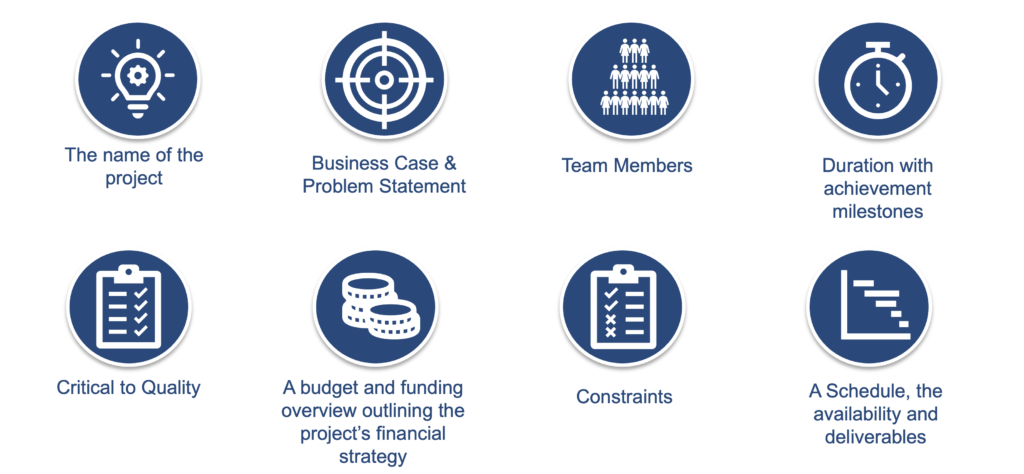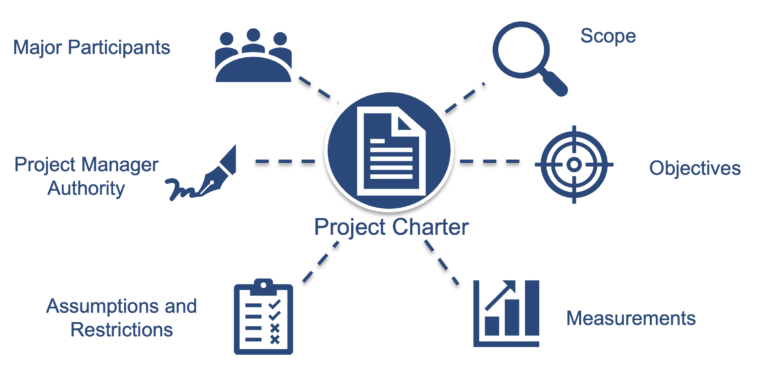The Project Management Institute defines the five stages of project management: project initiation, project planning, project execution, project monitoring and control, and project closure. In this article we are going to examine the very first question, that of project initiation. It is a decisive phase in project management. It enables the project to be defined in its entirety, including objectives, stakeholders, budget and constraints. To achieve this, it is necessary to draw up a project charter or business case that will define the detail of the project in question and lay a solid foundation, in preparation for moving onto the second phase, that of project planning.
The project charter or the business case
Depending on the scope of your project, you can draw up a project charter or a business case. These essential project management documents define the key elements of the project, its scope, objectives, stakeholders and delivery targets. While the two are similar in appearance, the second is more comprehensive and is used for the launch of a major project requiring a large quantity of material and human resources. To make things clearer, here are the details of each one:
The project charter
- Project description: A brief explanation of the project, including its objectives, rationale and expected benefits.
- Project objectives: The specific goals that the project aims to achieve. These objectives must be measurable and aligned with the needs of the organisation.
- Project scope: A detailed description of expected deliverables, project boundaries and acceptance criteria.
- Project team: A list of project team members, including the project manager, the responsibility of each member and key stakeholders.
- Budget: An estimate of the project’s costs, including the financial resources allocated, planned expenditure and funding sources.
- Planning: the project schedule, including the main stages, milestones and key dates.
- Risks and constraints: An assessment of the main risks associated with the project, as well as constraints such as strict deadlines or limit on resources.
- Project management methodology: A description of the methods, tools and processes that will be used to manage the project.
- Communication: The planned communication channels, reporting frequencies and the people responsible for communication in the project.
- Approval: The parties who must approve the project charter, typically the project sponsor and key stakeholders.
- References: Any relevant documentation or references, such as feasibility study reports, strategic plans, etc.
The business case
The business case contains the same elements as the project charter, but with the following additions:
- A comprehensive financial analysis, including an assessment of the expected return on investment (ROI) for the project.
- A project risk assessment, accompanied by a risk management plan.
- An action plan specifying how decisions will be taken, a communication plan, and the next steps to be taken if the business case is approved.

Stakeholder identification
Stakeholders include all the people who may have an influence on and a connection with the project, such as the project team, managers, directors, sponsors, etc. The objective here is to clearly identify them in order to present the project to them and obtain their approval if necessary.
To ensure no essential elements are missed, it is strongly recommended that a list of all the key internal and external stakeholders to be included in the project is drawn up. These can be arranged strategically by placing them in order of importance:
- High influence great interest
- High influence low interest
- Low influence high interest
- Low influence low interest
In addition, even stakeholders who do not need to approve the project can be brought into the loop so that they can “immerse” themselves in the project upstream. They can also make comments to help guide the project in the right direction.
Feasibility study
Once the project and its added value have been demonstrated, a feasibility study needs to be carried out. This study will ensure that the project is viable and feasible. It takes into account several parameters including resources, budget and deadlines in order to guarantee the conformity of the project. Generally speaking, the feasibility study is the key to the success of the project because it makes it possible to:
- Evaluate the probability of the project’s success: is the project feasible from a technical, economic and operational point of view?
- Reduce risks: by examining the technical, financial and organisational aspects of the project, the feasibility study identifies potential risks.
- Make informed decisions: it provides important information enabling stakeholders to make informed decisions.
- Plan the budget: this provides an estimate of expected costs and benefits, which is essential for drawing up a realistic budget and allocating resources appropriately.
- Plan the timetable: the feasibility study defines the stages of the project and draws up a realistic timetable for its completion.
- Strategic alignment: this ensures that the project is aligned with the organisation’s objectives and overall strategy.
- Mobilise resources: this helps to determine what resources (human, financial, material, etc.) will be needed to complete the project.
For small-scale projects, or if a similar project has been carried out in the past, a feasibility study may not be necessary. It is important to discuss this in advance with the stakeholders.
Set up the team and choose the tools
Last but not least of the steps: constitute the team. It is time to bring together all the essential driving forces to ensure the project runs smoothly. In project management, working collaboratively is essential.
The success of a project depends to some degree on its team. It is therefore essential to be careful when selecting the people you wish to be close to you, and to ensure that they have the necessary skills for the tasks you wish to assign to them. You may need to call on talent from outside the company, in which case it is best to start the process early.
To support your project team, you will also need to choose the project management software you wish to use to optimise their work process: Oracle Primavera, Oracle Primavera Cloud, EPPM, Microsoft Project, Project Online, Planisware, etc. Don’t forget that some of your staff may need to be trained on some of these tools and software. You should also bear in mind that other management tools such as dashboards, Kanban and Gantt charts can also help with project management, planning, task tracking, resource management and risk management. They are therefore the keys to success, guaranteeing the correct production of deliverables and the overall success of the project.




